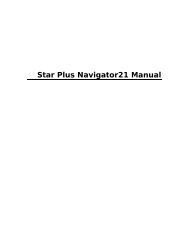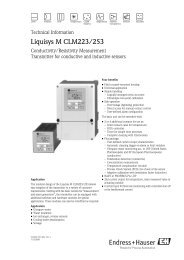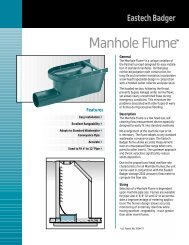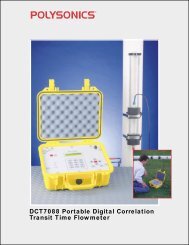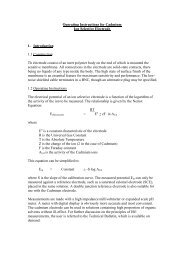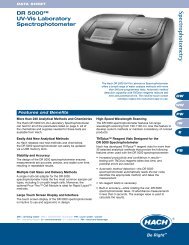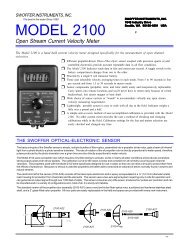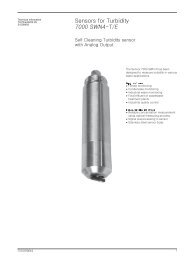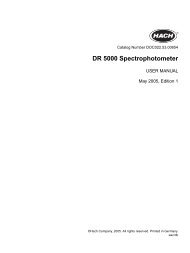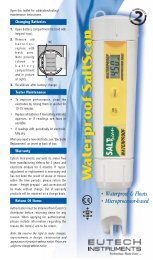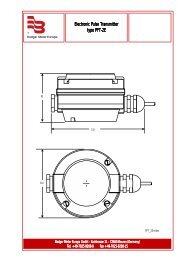Technical Data Sheet Chemical resistance of Grilon, Grilamid
Technical Data Sheet Chemical resistance of Grilon, Grilamid
Technical Data Sheet Chemical resistance of Grilon, Grilamid
Create successful ePaper yourself
Turn your PDF publications into a flip-book with our unique Google optimized e-Paper software.
<strong>Technical</strong> <strong>Data</strong> <strong>Sheet</strong><br />
<strong>Chemical</strong> <strong>resistance</strong> <strong>of</strong><br />
<strong>Grilon</strong>, <strong>Grilamid</strong>,<br />
<strong>Grilamid</strong> TR, Grivory GV<br />
and Grivory HTV<br />
Plastics play a key role, both in industry and in everyday life.<br />
It is, however, extremely important that a specific plastic, unaffected<br />
by the environment surrounding it, is chosen for each<br />
application.<br />
Generally speaking, polyamides are very resistant to all types<br />
<strong>of</strong> chemicals. Apart from concentrated acids, very few reagents<br />
attack polyamides.<br />
The following table showing the chemical <strong>resistance</strong> <strong>of</strong> <strong>Grilamid</strong>,<br />
<strong>Grilamid</strong> TR, Grivory GV and <strong>Grilon</strong> <strong>of</strong>fers guidance on<br />
the choice <strong>of</strong> polyamides for particular end uses.
The following table gives an indication <strong>of</strong> the chemical <strong>resistance</strong><br />
<strong>of</strong> <strong>Grilon</strong> (polyamide 6 and 66), <strong>Grilamid</strong> (polyamide<br />
12), <strong>Grilamid</strong> TR (transparent polyamide 12), Grivory GV (partially<br />
aromatic polyamide) and Grivory HTV (Polyphthalan 1).<br />
The chemical <strong>resistance</strong> was established by exposing test samples<br />
1 mm thick, to each <strong>of</strong> the chemicals for a period <strong>of</strong> 12<br />
months at room temperature. The results are valid both for<br />
unreinforced and for glass fibre reinforced products.<br />
Key:<br />
Resistant. Negligible, reversible or no changes in mass<br />
and dimensions. Example: <strong>Grilon</strong> unaffected by<br />
aqueous and alcoholic media.<br />
Limited <strong>resistance</strong>. Considerable dimensional changes,<br />
and possibly irreversible changes in properties<br />
after prolonged contact. Consultation advisable before<br />
use.<br />
Not resistant. May be used under certain conditions<br />
(brief contact).<br />
Soluble or attacked after brief contact.<br />
*signifies data valid for all concentrations<br />
Certain additives, particularly plasticizers, may be dissolved<br />
out into the medium. Absorption <strong>of</strong> the medium is generally sufficient,<br />
however, to compensate for any resultant loss in flexibility.<br />
The data regarding chemical <strong>resistance</strong> refers to stress-free products.<br />
Stresses in parts <strong>of</strong> <strong>Grilamid</strong> TR can lead to cracking<br />
when coming into contact with specific solvents.<br />
Particular information can be found in the section «Environmental<br />
Stress Cracking».<br />
Environmental Stress Cracking <strong>of</strong> <strong>Grilamid</strong> TR<br />
Amorphous thermoplastics such as <strong>Grilamid</strong> TR can develop<br />
stress cracking when exposed to certain media. Components<br />
are more likely to develop stress cracking symptoms when they<br />
are subjected to external stresses, or when, through unsuitable<br />
processing, they have high internal stresses.<br />
<strong>Grilamid</strong> TR 55, <strong>Grilamid</strong> TR 70 LX and <strong>Grilamid</strong> TR 90 are<br />
not resistant to the following chemicals and stress cracking may<br />
occur: Benzyl alcohol, butanol, butylene glycol, ethanol, isopropanol,<br />
methanol, phenyl ethyl alcohol, propanol.<br />
<strong>Grilamid</strong> TR 55 and <strong>Grilamid</strong> TR 70 LZ have limited (short term)<br />
chemical <strong>resistance</strong> to the following chemicals but stress cracking<br />
may occur under conditions <strong>of</strong> high internal or external<br />
stress: Acetone, amyl acetate, benzaldehyde, butyl acetate,<br />
cyclohexanone, diethyl ether, etheric oils, ethyl acetate, isopropanol<br />
80%, methyl ethyl ketone, phenyl ethyl alcohol, pyridine,<br />
tetrahydr<strong>of</strong>uran.<br />
<strong>Grilamid</strong> TR 90 has limited (short term) <strong>resistance</strong> to the following<br />
chemicals, but stress cracking may occur in: amyl acetate,<br />
benzaldehyde, butyl acetate, cyclohexanone, etheric oils, phenyl<br />
ethyl alcohol, pyridine.<br />
The chemical <strong>resistance</strong> is dependant both on the temperature<br />
and the stress condition <strong>of</strong> the finished component. The suitability<br />
<strong>of</strong> any material for a specific application must be confirmed<br />
by a practical test.<br />
Medium <strong>Chemical</strong> formula Concentration Resistance<br />
<strong>Grilon</strong> <strong>Grilamid</strong> <strong>Grilamid</strong> TR Grivory GV Grivory HTV<br />
Acetaldehyde CH 3 —CHO 40 % aq. soln. <br />
Acetamide CH 3 —CO—NH 2 50 % aq. soln. <br />
Acetic acid CH 3 COOH 10 % aq. soln. <br />
Acetic acid CH 3 COOH 40 % aq. soln. <br />
Acetic acid CH 3 COOH technically pure <br />
Acetic anhydride CH 3 –CO–O–OC–CH 3 technically pure <br />
Acetone CH 3 —CO—CH 3 technically pure <br />
Allyl alcohol H 2 C=CH–CH 2 –OH technically pure <br />
Aluminium salts — *, aq. soln. <br />
Alums K 2 SO 4 —Al 2 (SO 4 ) 3 · 12 H 2 O *, aq. soln. <br />
Ammonia NH 3 10 % aq. soln. <br />
Ammonia NH 3 *, gaseous <br />
Ammonium chloride NH 4 Cl 10 % aq. soln. <br />
Ammonium salts — *, technically pure <br />
Amyl acetate CH 3 (CH 2 ) 4 —OOCCH 3 technically pure <br />
Amyl alcohol CH 3 (CH 2 ) 3 —CH 2 —OH technically pure <br />
Aniline C 6 H 5 –NH 2 technically pure <br />
2
Medium <strong>Chemical</strong> formula Concentration Resistance<br />
<strong>Grilon</strong> <strong>Grilamid</strong> <strong>Grilamid</strong> TR Grivory GV Grivory HTV<br />
Anisole C 6 H 5 —O—CH 3 technically pure <br />
Aqua regia HNO 3 + HCI technically pure <br />
Aspirin — technically pure <br />
Attar <strong>of</strong> roses (Rose oil) — technically pure <br />
Barium salts — *, aq. soln. <br />
Battery acid H 2 SO4 36 % aq. soln. <br />
Beer — commercial grade <br />
Benzaldehyde C 6 H 5 CHO technically pure <br />
Benzoic acid C 6 H 5 —COOH *, aq. soln. <br />
Benzene C 6 H 6 technically pure <br />
Benzyl alcohol C 6 H 5 —CH 2 OH technically pure <br />
Bitumen — commercial grade <br />
Borax Na 2 B 4 O 7 *, aq. soln. <br />
Boric acid H 3 BO 3 10 % aq. soln. <br />
Brake fluid (DOT 4) — commercial grade <br />
Brandy — commercial grade <br />
Bromine Br 2 * <br />
Butane C 4 H 10 technically pure <br />
Butanol C 4 H 9 OH technically pure <br />
Butter — commercial grade <br />
Butter milk — commercial grade <br />
Butyl acetate CH 3 COOCH 2 CH 2 CH 2 CH 3 technically pure <br />
Butyric acid CH 3 CH 2 CH 2 —COOH technically pure <br />
Butylene glycol HO—CH 2 CH 2 CH 2 CH 2 —OH technically pure <br />
Calcium chloride CaCl 2 10 % aq. soln. <br />
Calcium chloride CaCl 2 20 % alcoholic soln. <br />
Camphor — technically pure <br />
Carbon disulphide CS 2 100 % <br />
Carbon tetrachloride CCI 4 technically pure <br />
Caustic soda NaOH 40 % aq. soln. <br />
Chlorinated lime Ca(CIO) 2 *, aq. soln. <br />
Chlorine Cl 2 technically pure <br />
Chlorine gas Cl 2 < 5 %, gaseous <br />
Chlorine water — < 5 %, aq. soln. <br />
Chloroacetic acid CICH 2 COOH 10 %, technically pure <br />
Chlorobenzene C 6 H 5 —Cl technically pure <br />
Chlorobrommethane CH 2 ClBr technically pure <br />
Chlor<strong>of</strong>orm CHCl 3 technically pure <br />
Chromic acid H 2 CrO 4 10 % aq. soln. <br />
Chromic acid H 2 CrO 4 1% aq. soln. <br />
Chromic/sulphuric acid H 2 SO 4 /CrO 3 *, aq. soln. <br />
Chromium salts — *, aq. soln. <br />
Coca-Cola — commercial grade <br />
Cocoa — commercial grade <br />
C<strong>of</strong>fee — commercial grade <br />
Copper salts — 10 % aq. soln. <br />
Cresol H 3 C–C 6 H 4 –OH technically pure <br />
3
Medium <strong>Chemical</strong> formula Concentration Resistance<br />
<strong>Grilon</strong> <strong>Grilamid</strong> <strong>Grilamid</strong> TR Grivory GV Grivory HTV<br />
Cyclohexane C 6 H 12 technically pure <br />
Cyclohexanol C 6 H 11 OH technically pure <br />
Cyclohexanone C 6 H 10 O technically pure <br />
Decalin C 10 H 18 technically pure <br />
Dibutyl phthalate C 6 H 4 —(COOC 4 H 9 ) 2 technically pure <br />
Diesel — commercial grade <br />
Diesel oil — commercial grade <br />
Diethyl ether CH 3 —CH 2 —O—CH 2 —CH 3 technically pure <br />
Dimethyl formamide HCON—(CH 3 ) 2 technically pure <br />
Dioctyl phthalate C 6 H 4 —(COOC 8 H 17 ) 2 technically pure <br />
Dioxane C 4 H 8 O 2 technically pure <br />
Edible fats and oils — commercial grade <br />
Ethanol CH 3 CH 2 OH technically pure <br />
Ether CH 3 CH 2 —O—CH 2 CH 3 technically pure <br />
Ethyl acetate CH 3 COOCH 2 CH 3 technically pure <br />
Ethylene chloride ClCH 2 —CH 2 Cl technically pure <br />
FAM B — technically pure <br />
Formaldehyde (Formalin) HCHO 40 % aq. soln. <br />
Formamide HCONH 2 technically pure <br />
Formic acid HCOOH 10 % aq. soln. <br />
Formic acid HCOOH 40 % aq. soln. <br />
Formic acid HCOOH 85 % aq. soln. <br />
Freon partially halogenized commercial grade <br />
fully halogenized commercial grade <br />
Freon 12 CF 2 Cl 2 technically pure <br />
Freon 22 CHF 2 Cl technically pure <br />
Fruit juices — commercial grade <br />
Fuel C free from lead technically pure <br />
Fuel oil — technically pure <br />
Furfurol C 4 H 3 O—CHO technically pure <br />
Glycerine C 3 H 8 O 3 technically pure <br />
Glycol HO—CH 2 CH 2 —OH technically pure <br />
Heptane C 7 H 16 technically pure <br />
Hexane C 6 H 14 technically pure <br />
Hydraulic fluid — commercial grade <br />
Hydrochloric acid HCI 10 % aq. soln. <br />
Hydrochloric acid HCI 1 % aq. soln. <br />
Hydrogen fluoride HF 40 % aq. soln. <br />
Hydrogen peroxide H 2 O 2 30 % aq. soln. <br />
Hydrogen peroxide H 2 O 2 10 % aq. soln. <br />
Hydrogen peroxide H 2 O 2 2 % aq. soln. <br />
Hydrogen sulphide H 2 S < 5 %, gaseous <br />
Ink — commercial grade <br />
Iodine tincture J 2 *, alcoholic soln. <br />
Iron salts — 20 % aq. soln. neut. <br />
Iron salts — 20 % aq. soln. acid. <br />
Isooctane (CH 3 ) 3 C–CH 2 CH(CH 3 ) 2 technically pure <br />
4
Medium <strong>Chemical</strong> formula Concentration Resistance<br />
<strong>Grilon</strong> <strong>Grilamid</strong> <strong>Grilamid</strong> TR Grivory GV Grivory HTV<br />
Isopropyl alcohol (CH 3 ) 3 –CHOH technically pure <br />
Lactic acid CH 3 CH(OH)–COOH 90 % aq. soln. <br />
Lactic acid CH 3 CH(OH)–COOH 50 % aq. soln. <br />
Lactic acid CH 3 CH(OH)–COOH 5 % aq. soln. <br />
Lanolin — commercial grade <br />
Lead salts — technically pure <br />
Lemon juice — *, commercial grade <br />
Linseed oil — commercial grade <br />
Liqueurs — commercial grade <br />
Lubrications oils,<br />
greases, soaps — commercial grade <br />
Magnesium hydroxide Mg(OH) 2 10 % aq. soln. <br />
Magnesium salts — 10 % aq. soln. <br />
Mercury Hg technically pure <br />
Mercury salts — *, aq. soln., neutral <br />
Methanol CH 3 OH technically pure <br />
Methylene chloride CH 2 Cl 2 technically pure <br />
Methylethyl ketone CH 3 —CO—CH 2 —CH 3 technically pure <br />
Milk — commercial grade <br />
Mineral oils — commercial grade <br />
Motor fuels — commercial grade <br />
Naphthalene C 10 H 8 technically pure <br />
Nickel salts — *, aq. soln. <br />
Nitric acid HNO 3 *, aq. soln. <br />
Nitrobenzene C 6 H 5 NO 2 technically pure <br />
Nitromethane CH 3 NO 2 technically pure <br />
Octane C 8 H 18 technically pure <br />
Oil (No. 3 ASTM) — commercial grade <br />
Oil <strong>of</strong> lavendar — commercial grade <br />
Oil <strong>of</strong> pine needle — technically pure <br />
Oil <strong>of</strong> turpentine — technically pure <br />
Oleic acid — technically pure <br />
Oleum H 2 SO 4 +SO 3 technically pure <br />
Olive oil — commercial grade <br />
Oxalic acid HOOC—COOH 10 % aq. soln. <br />
Ozone O 3 *, gaseous <br />
Ozone O 3 < 1ppm, gaseous <br />
Paraffin oil — technically pure <br />
Peanut oil — commercial grade <br />
Peppermint oil — technically pure <br />
Perchlorethylene Cl 2 C=CCl 2 technically pure <br />
Petrol (unleaded, Esso) — commercial grade <br />
Petroleum — technically pure <br />
Petroleum ether — technically pure <br />
Phenol C 6 H 5 OH *, aq. soln. <br />
Phenylethyl alcohol H 3 C—CH(C 6 H 5 )—OH technically pure <br />
Phosphoric acid H 3 PO 4 50 % aq. soln. <br />
5
Medium <strong>Chemical</strong> formula Concentration Resistance<br />
<strong>Grilon</strong> <strong>Grilamid</strong> <strong>Grilamid</strong> TR Grivory GV Grivory HTV<br />
Phosphoric acid H 3 PO 4 10 % aq. soln. <br />
Plasticizers<br />
(phthalates, phosphates) — commercial grade <br />
Potash K 2 CO 3 *, aq. soln. <br />
Potassium bromide KBr 10 % aq. soln. <br />
Potassium chlorate KCIO 3 7 % aq. soln. <br />
Potassium hydroxide KOH 50 % aq. soln. <br />
Potassium iodide KJ 10 % aq. soln. <br />
Potassium nitrate KNO 3 10 % aq. soln. <br />
Potassium permanganate KMnO 4 1 % aq. soln. <br />
Potassium sulphate K 2 SO 4 10 % aq. soln. <br />
Propane C 3 H 8 technically pure <br />
Propanol C 3 H 7 OH technically pure <br />
Pyridine C 5 H 5 N technically pure <br />
Pyrocatechol HO—C 6 H 4 —OH 6 % aq. soln. <br />
Resorcinol HO—C 6 H 4 —OH technically pure <br />
Resorcinol HO—C 6 H 4 —OH *, alcoholic soln. <br />
Rum — commercial grade <br />
Salicylic acid HO—C 6 H 4 —COOH technically pure <br />
Silicone oils — technically pure <br />
Silver salts — *, aq. soln. <br />
Soap solution — 10 % aq. soln. <br />
Sodium bicarbonate NaHCO 3 *, aq. soln. <br />
Sodium bisulphite NaHSO 3 10 % aq. soln. <br />
Sodium bromide NaBr 10 % aq. soln. <br />
Sodium carbonate Na 2 CO 3 10 % aq. soln. <br />
Sodium chloride NaCI *, aq. soln. <br />
Sodium chlorite NaCIO 2 5 % aq. soln. <br />
Sodium hydroxide NaOH 40 % aq. soln. <br />
Sodium hypochlorite NaOCI 5 % aq. soln. <br />
Sodium nitrate NaNO 3 10 % aq. soln. <br />
Sodium nitrite NaNO 2 5 % aq. soln. <br />
Sodium perborate — 5 % aq. soln. <br />
Sodium phosphate Na 3 PO 4 10 % aq. soln. <br />
Sodium sulphate Na 2 SO 4 10 % aq. soln. <br />
Sodium sulphide Na 2 S 10 % aq. soln. <br />
Sodium sulphite Na 2 SO 3 10 % aq. soln. <br />
Sodium thiosulphite Na 2 S 2 O 3 10 % aq. soln. <br />
Soya oil — commercial grade <br />
Starch — *, aq. soln. <br />
Styrene C 6 H 5 –CH=CH 2 technically pure <br />
Sugar C 6 H 12 O 6 *, aq. soln. <br />
Sulphur S technically pure <br />
Sulphur dioxide SO 2 < 5 % <br />
Sulphuric acid H 2 SO 4 technically pure <br />
Sulphuric acid H 2 SO 4 36 % aq. soln. <br />
Sulphuric acid H 2 SO 4 10 % aq. soln. <br />
6
Medium <strong>Chemical</strong> formula Concentration Resistance<br />
<strong>Grilon</strong> <strong>Grilamid</strong> <strong>Grilamid</strong> TR Grivory GV Grivory HTV<br />
Sulphuric acid H 2 SO 4 2 % aq. soln. <br />
Table salt NaCl *, aq. soln. <br />
Tallow — commercial grade <br />
Tar — technically pure <br />
Tartaric acid HOOC–CH(OH)–CH(OH)–COOH technically pure <br />
Tea — commercial grade <br />
Tetrahydr<strong>of</strong>uran C 4 H 8 O technically pure <br />
Tetralin C 10 H 12 technically pure <br />
Thionyl chloride SOCl 2 technically pure <br />
Toluene C 6 H 5 —CH 3 technically pure <br />
Trichlorethylene Cl 2 C=CHCl technically pure <br />
Urea H 2 N–CO–NH 2 20 % aq. soln. <br />
Vaseline — commercial grade <br />
Vinegar CH 3 COOH commercial grade <br />
Water H 2 O technically pure <br />
Water glass — *, aq. soln. <br />
Wax — commercial grade <br />
Wine — commercial grade <br />
Xylene H 3 C—C 6 H 4 —CH 3 technically pure <br />
Zinc chloride ZnCl 2 10 % aq. soln. <br />
The recommendations and data given are based on our experience<br />
to date. No liability can be assumed in connection with<br />
their usage and processing.<br />
Domat/Ems, June 2001<br />
7



